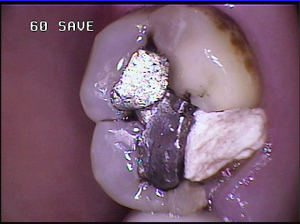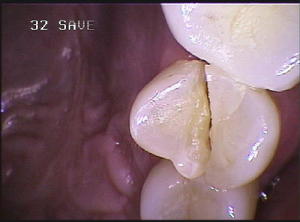By Arthur Kezian
The name “Cracked Tooth Syndrome” may sound totally terrifying, but it’s actually a very common ailment. Luckily, a good dentist can diagnose it and treat it quickly and easily!
So, what exactly is it?
Cracked Tooth Syndrome is a fancy name for tiny fractures in your teeth. Depending on the severity of your specific case, you might have relatively minor fractures. However, it is possible for these fractures to go all the way down to your nerve endings.
 Typically, the fractures associated with Cracked Tooth Syndrome affect your bottom molars, because those are the teeth that you use most for chewing. However, any tooth that has a filling or teeth that are misaligned are at a higher risk of developing fractures.
Typically, the fractures associated with Cracked Tooth Syndrome affect your bottom molars, because those are the teeth that you use most for chewing. However, any tooth that has a filling or teeth that are misaligned are at a higher risk of developing fractures.
But in many cases, these fractures are so small that your dentist can’t even see them on an x-ray!
Then how do you know they’re there?
A good dentist will have special tools to find them. There’s even a special dye that can make tiny fractures visible.
But how will your dentist in Larchmont even know to look for them?
In most cases, Cracked Tooth Syndrome causes you pain. Oftentimes, though, it can take awhile to diagnose Cracked Tooth Syndrome because the pain associated with it isn’t constant. Instead, it’s usually incredibly random! You might be in excruciating pain during certain meals, while other meals are completely pain-free. You might only be in pain when you eat very hot or very cold foods. As a result, you and your dentist will have to pinpoint exactly when the pain occurs and go from there.
 The key to Cracked Tooth Syndrome pain is that it only occurs when you eat, indicating a potential for getting a porcelain crown. If the pain stops as soon as you stop eating, that’s a good indication that tiny fractures are to blame. If the pain comes and goes regardless of your eating habits, odds are that something besides Cracked Tooth Syndrome is responsible for it.
The key to Cracked Tooth Syndrome pain is that it only occurs when you eat, indicating a potential for getting a porcelain crown. If the pain stops as soon as you stop eating, that’s a good indication that tiny fractures are to blame. If the pain comes and goes regardless of your eating habits, odds are that something besides Cracked Tooth Syndrome is responsible for it.
How will your dentist treat cracked tooth syndrome?
Once it’s diagnosed, this is a relatively easy problem to solve. Porcelain crowns are the most common solution. When you get a porcelain crown, your dentist will put little “caps” over your tooth. That way, your tooth will be protected from further damage.
If the pain doesn’t stop after your crown is installed — or if the fracture goes all the way to your tooth’s root — even the best dentist may not be able to save your tooth. These cases are rare, but if it happens to you, a good dentist can fit you with a dental implant that looks completely natural.
Is there anything you can do to prevent cracked tooth syndrome?
Yes!
Stop any bad habits — like chewing on ice or chewing on pens. The less stress you put on your teeth, the lower your chances of developing a crack!
Dr. Arthur A. Kezian DDS 443 N. Larchmont Blvd Los Angeles, CA 90004 (323) 467-2777
